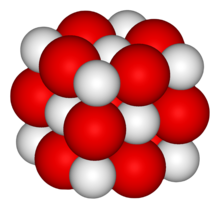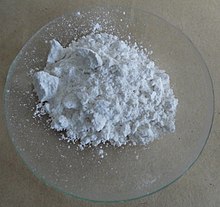Calcium oxide
 | |
 | |
| Names | |
|---|---|
IUPAC name Calcium oxide | |
| Other names Quicklime, burnt lime, unslaked lime, pebble lime, calcia | |
| Identifiers | |
CAS Number |
|
3D model (JSmol) |
|
ChEBI |
|
ChEMBL |
|
ChemSpider |
|
ECHA InfoCard | 100.013.763 |
E number | E529 (acidity regulators, ...) |
Gmelin Reference | 485425 |
PubChem CID |
|
RTECS number | EW3100000 |
UNII |
|
UN number | 1910 |
InChI
| |
SMILES
| |
| Properties | |
Chemical formula | CaO |
Molar mass | 56.0774 g/mol |
| Appearance | White to pale yellow/brown powder |
Odor | Odorless |
Density | 3.34 g/cm3[1] |
Melting point | 2,613 °C (4,735 °F; 2,886 K)[1] |
Boiling point | 2,850 °C (5,160 °F; 3,120 K) (100 hPa)[2] |
Solubility in water | Reacts to form calcium hydroxide |
Solubility in Methanol | Insoluble (also in diethyl ether, octanol) |
Acidity (pKa) | 12.8 |
Magnetic susceptibility (χ) | −15.0×10−6 cm3/mol |
| Structure | |
Crystal structure | Cubic, cF8 |
| Thermochemistry | |
Std molar entropy (S | 40 J·mol−1·K−1[3] |
Std enthalpy of formation (ΔfH | −635 kJ·mol−1[3] |
| Pharmacology | |
ATCvet code | QP53AX18 (WHO) |
| Hazards | |
Safety data sheet | Hazard.com |
NFPA 704 |  0 3 2 |
Flash point | Non-flammable [4] |
| US health exposure limits (NIOSH): | |
PEL (Permissible) | TWA 5 mg/m3[4] |
REL (Recommended) | TWA 2 mg/m3[4] |
IDLH (Immediate danger) | 25 mg/m3[4] |
| Related compounds | |
Other anions | Calcium sulfide Calcium hydroxide |
Other cations | Beryllium oxide Magnesium oxide Strontium oxide Barium oxide |
Except where otherwise noted, data are given for materials in their standard state (at 25 °C [77 °F], 100 kPa). | |
Infobox references | |
Calcium oxide (CaO), commonly known as quicklime or burnt lime, is a widely used chemical compound. It is a white, caustic, alkaline, crystalline solid at room temperature. The broadly used term lime connotes calcium-containing inorganic materials, in which carbonates, oxides and hydroxides of calcium, silicon, magnesium, aluminium, and iron predominate. By contrast, quicklime specifically applies to the single chemical compound calcium oxide. Calcium oxide that survives processing without reacting in building products such as cement is called free lime.[5]
Quicklime is relatively inexpensive. Both it and a chemical derivative (calcium hydroxide, of which quicklime is the base anhydride) are important commodity chemicals.
Contents
1 Preparation
2 Uses
2.1 Weapon
3 Safety
4 References
5 External links
Preparation
Calcium oxide is usually made by the thermal decomposition of materials, such as limestone or seashells, that contain calcium carbonate (CaCO3; mineral calcite) in a lime kiln. This is accomplished by heating the material to above 825 °C (1,517 °F),[6] a process called calcination or lime-burning, to liberate a molecule of carbon dioxide (CO2), leaving quicklime.
- CaCO3(s) → CaO(s) + CO2(g)
The quicklime is not stable and, when cooled, will spontaneously react with CO2 from the air until, after enough time, it will be completely converted back to calcium carbonate unless slaked with water to set as lime plaster or lime mortar.
Annual worldwide production of quicklime is around 283 million tonnes. China is by far the world's largest producer, with a total of around 170 million tonnes per year. The United States is the next largest, with around 20 million tonnes per year.[7]
Approximately 1.8 t of limestone is required per 1.0 t of quicklime. Quicklime has a high affinity for water and is a more efficient desiccant than silica gel. The reaction of quicklime with water is associated with an increase in volume by a factor of at least 2.5.[8]
Uses
 Play media
Play mediaA demonstration of slaking of quicklime as a strongly exothermic reaction. Drops of water are added to pieces of quicklime. After a while, a pronounced exothermic reaction occurs ('slaking of lime'). The temperature can reach up to some 300 °C (572 °F).
- The major use of quicklime is in the basic oxygen steelmaking (BOS) process. Its usage varies from about 30 to 50 kilograms (65–110 lb) per ton of steel. The quicklime neutralizes the acidic oxides, SiO2, Al2O3, and Fe2O3, to produce a basic molten slag.[8]
- Ground quicklime is used in the production of aerated concrete blocks, with densities of ca. 0.6–1.0 g/cm3 (9.8–16.4 g/cu in).[8]
- Quicklime and hydrated lime can considerably increase the load carrying capacity of clay-containing soils. They do this by reacting with finely divided silica and alumina to produce calcium silicates and aluminates, which possess cementing properties.[8]
- Small quantities of quicklime are used in other processes; e.g., the production of glass, calcium aluminate cement, and organic chemicals.[8]
- Heat: Quicklime releases Thermal energy by the formation of the hydrate, calcium hydroxide, by the following equation:[9]
- CaO (s) + H2O (l) ⇌ Ca(OH)2 (aq) (ΔHr = −63.7 kJ/mol of CaO)
- As it hydrates, an exothermic reaction results and the solid puffs up. The hydrate can be reconverted to quicklime by removing the water by heating it to redness to reverse the hydration reaction. One litre of water combines with approximately 3.1 kilograms (6.8 lb) of quicklime to give calcium hydroxide plus 3.54 MJ of energy. This process can be used to provide a convenient portable source of heat, as for on-the-spot food warming in a self-heating can, cooking, and heating water without open flames. Several companies sell cooking kits using this heating method.[10]
- It is known as a food additive to the FAO as an acidity regulator, a flour treatment agent and as a leavener.[11] It has E number E529.
- Light: When quicklime is heated to 2,400 °C (4,350 °F), it emits an intense glow. This form of illumination is known as a limelight, and was used broadly in theatrical productions before the invention of electric lighting.[12]
- Cement: Calcium oxide is a key ingredient for the process of making cement.
- As a cheap and widely available alkali. About 50% of the total quicklime production is converted to calcium hydroxide before use. Both quick- and hydrated lime are used in the treatment of drinking water.[8]
- Petroleum industry: Water detection pastes contain a mix of calcium oxide and phenolphthalein. Should this paste come into contact with water in a fuel storage tank, the CaO reacts with the water to form calcium hydroxide. Calcium hydroxide has a high enough pH to turn the phenolphthalein a vivid purplish-pink color, thus indicating the presence of water.
- Paper: Calcium oxide is used to regenerate sodium hydroxide from sodium carbonate in the chemical recovery at Kraft pulp mills.
- Plaster: There is archeological evidence that Pre-Pottery Neolithic B humans used limestone-based plaster for flooring and other uses.[13][14][15] Such Lime-ash floor remained in use until the late nineteenth century.
- Chemical or power production: Solid sprays or slurries of calcium oxide can be used to remove sulfur dioxide from exhaust streams in a process called flue-gas desulfurization.
- Mining: Compressed lime cartridges exploit the exothermic properties of quicklime to break rock. A shot hole is drilled into the rock in the usual way and a sealed cartridge of quicklime is placed within and tamped. A quantity of water is then injected into the cartridge and the resulting release of steam, together with the greater volume of the residual hydrated solid, breaks the rock apart. The method does not work if the rock is particularly hard.[16][17][18]
Weapon
In 80 BC, the Roman general Sertorius deployed choking clouds of caustic lime powder to defeat the Characitani of Hispania, who had taken refuge in inaccessible caves.[19] A similar dust was used in China to quell an armed peasant revolt in 178 AD, when lime chariots equipped with bellows blew limestone powder into the crowds.[20]
Quicklime is also thought to have been a component of Greek fire. Upon contact with water, quicklime would increase its temperature above 150 °C (302 °F) and ignite the fuel.[21]
David Hume, in his History of England, recounts that early in the reign of Henry III, the English Navy destroyed an invading French fleet by blinding the enemy fleet with quicklime.[22] Quicklime may have been used in medieval naval warfare - up to the use of "lime-mortars" to throw it at the enemy ships.[23]
Safety
Because of vigorous reaction of quicklime with water, quicklime causes severe irritation when inhaled or placed in contact with moist skin or eyes. Inhalation may cause coughing, sneezing, labored breathing. It may then evolve into burns with perforation of the nasal septum, abdominal pain, nausea and vomiting. Although quicklime is not considered a fire hazard, its reaction with water can release enough heat to ignite combustible materials.[24]
References
^ ab Haynes, William M., ed. (2011). CRC Handbook of Chemistry and Physics (92nd ed.). Boca Raton, FL: CRC Press. p. 4.55. ISBN 1439855110..mw-parser-output cite.citation{font-style:inherit}.mw-parser-output .citation q{quotes:"""""""'""'"}.mw-parser-output .citation .cs1-lock-free a{background:url("//upload.wikimedia.org/wikipedia/commons/thumb/6/65/Lock-green.svg/9px-Lock-green.svg.png")no-repeat;background-position:right .1em center}.mw-parser-output .citation .cs1-lock-limited a,.mw-parser-output .citation .cs1-lock-registration a{background:url("//upload.wikimedia.org/wikipedia/commons/thumb/d/d6/Lock-gray-alt-2.svg/9px-Lock-gray-alt-2.svg.png")no-repeat;background-position:right .1em center}.mw-parser-output .citation .cs1-lock-subscription a{background:url("//upload.wikimedia.org/wikipedia/commons/thumb/a/aa/Lock-red-alt-2.svg/9px-Lock-red-alt-2.svg.png")no-repeat;background-position:right .1em center}.mw-parser-output .cs1-subscription,.mw-parser-output .cs1-registration{color:#555}.mw-parser-output .cs1-subscription span,.mw-parser-output .cs1-registration span{border-bottom:1px dotted;cursor:help}.mw-parser-output .cs1-ws-icon a{background:url("//upload.wikimedia.org/wikipedia/commons/thumb/4/4c/Wikisource-logo.svg/12px-Wikisource-logo.svg.png")no-repeat;background-position:right .1em center}.mw-parser-output code.cs1-code{color:inherit;background:inherit;border:inherit;padding:inherit}.mw-parser-output .cs1-hidden-error{display:none;font-size:100%}.mw-parser-output .cs1-visible-error{font-size:100%}.mw-parser-output .cs1-maint{display:none;color:#33aa33;margin-left:0.3em}.mw-parser-output .cs1-subscription,.mw-parser-output .cs1-registration,.mw-parser-output .cs1-format{font-size:95%}.mw-parser-output .cs1-kern-left,.mw-parser-output .cs1-kern-wl-left{padding-left:0.2em}.mw-parser-output .cs1-kern-right,.mw-parser-output .cs1-kern-wl-right{padding-right:0.2em}
^ Calciumoxid Archived 2013-12-30 at the Wayback Machine. GESTIS database
^ ab Zumdahl, Steven S. (2009). Chemical Principles 6th Ed. Houghton Mifflin Company. p. A21. ISBN 0-618-94690-X.
^ abcd NIOSH Pocket Guide to Chemical Hazards. "#0093". National Institute for Occupational Safety and Health (NIOSH).
^ "free lime". DictionaryOfConstruction.com.
^ Merck Index of Chemicals and Drugs, 9th edition monograph 1650
^ Miller, M. Michael (2007). "Lime". Minerals Yearbook (PDF). U.S. Geological Survey. p. 43.13.
^ abcdef Tony Oates (2007), "Lime and Limestone", Ullmann's Encyclopedia of Industrial Chemistry (7th ed.), Wiley, pp. 1–32, doi:10.1002/14356007.a15_317, ISBN 3527306730
^ Collie, Robert L. "Solar heating system" U.S. Patent 3,955,554 issued May 11, 1976
^ Gretton, Lel. "Lime power for cooking - medieval pots to 21st century cans". Old & Interesting. Retrieved 13 February 2018.
^ "Compound Summary for CID 14778 - Calcium Oxide". PubChem.
^ Gray, Theodore (September 2007). "Limelight in the Limelight". Popular Science: 84.
^ Neolithic man: The first lumberjack?. Phys.org (August 9, 2012). Retrieved on 2013-01-22.
^ Karkanas, P.; Stratouli, G. (2011). "Neolithic Lime Plastered Floors in Drakaina Cave, Kephalonia Island, Western Greece: Evidence of the Significance of the Site". The Annual of the British School at Athens. 103: 27. doi:10.1017/S006824540000006X.
^ Connelly, Ashley Nicole (May 2012) Analysis and Interpretation of Neolithic Near Eastern Mortuary Rituals from a Community-Based Perspective. Baylor University Thesis, Texas
^ Walker, Thomas A (1888). The Severn Tunnel Its Construction and Difficulties. London: Richard Bentley and Son. p. 92.
^ "Scientific and Industrial Notes". Manchester Times. Manchester, England: 8. 13 May 1882.
^ US Patent 255042, 14 March 1882
^ Plutarch, "Sertorius 17.1–7", Parallel Lives.
^ Adrienne Mayor (2005), "Ancient Warfare and Toxicology", in Philip Wexler, Encyclopedia of Toxicology, 4 (2nd ed.), Elsevier, pp. 117–121, ISBN 0-12-745354-7
^ Croddy, Eric (2002). Chemical and biological warfare: a comprehensive survey for the concerned citizen. Springer. p. 128. ISBN 0-387-95076-1.
^ David Hume (1756). History of England. I.
^ Sayers W. The Use of Quicklime in Medieval Naval Warfare // The Mariner's Mirror. - Volume 92 (2006). - Issue 3. - PP. 262-269.
^ CaO MSDS. hazard.com
External links
| Wikimedia Commons has media related to Calcium oxide. |
Lime Statistics & Information from the United States Geological Survey
- Factors Affecting the Quality of Quicklime
American Scientist (discussion of 14C dating of mortar)- Chemical of the Week – Lime
- Material Safety Data Sheet
- CDC - NIOSH Pocket Guide to Chemical Hazards